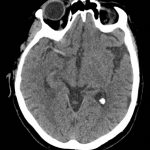Dense MCA Sign
History of present illness:
A 77-year-old female presented to the emergency department after being found down at home, last seen normal 7 ½ hours prior to arrival. Patient had a history of hypertension, congestive heart failure, atrial fibrillation and breast cancer status post chemotherapy/radiation and lumpectomy. Physical exam showed right gaze preference, left facial droop and tongue deviation and flaccid left hemiplegia.
Significant findings:
A non-contrast computed tomography (CT) scan showed a hyperdensity along the right middle cerebral artery (MCA) consistent with acute thrombus. The red arrow highlights the hyperdensity in the annotated image.
Discussion:
The dense MCA sign can serve as an important tool in the diagnosis of acute stroke. It typically appears before other signs of infarct are apparent on CT imaging, and identifies an intracranial large artery occlusion and corresponding infarct, in the correct clinical setting.1 Calcifications in the same area of the brain could be mistaken for an MCA sign, but this sign carries a high specificity (95%) and lower sensitivity (52%) for arterial obstruction in ischemic stroke.2 Early identification allows for a wider array of treatment options for a patient with an ischemic stroke, including intra-venous or intra-arterial thrombolysis and mechanical thrombectomy.
This patient was subsequently taken for mechanical thrombectomy. Mechanical thrombectomy was chosen for this patient because the resources were available, and recent clinical trials have shown that newer types of mechanical thrombectomy have a positive functional outcome in patients with an ischemic stroke from an intracranial large artery occlusion, as compared to intravenous tissue plasminogen activator (tPa) alone.3,4,5,6 In facilities lacking the capability for mechanical thrombectomy, treatment considerations include rapid transfer to a facility with capability, or proceeding with intravenous tPa. After intervention, this patient had residual left sided deficits and dysarthria that were improved from presentation. She had an uncomplicated hospital course and was discharged to acute rehabilitation.
Topics:
Neurology, stroke, cerebral vascular accident, CVA, non-contrast head CT, MCA occlusion.
References:
- Leys D, Pruvo JP, Godefroy O, Rondepierre P, Leclerc X. Prevalence and significance of hyperdense middle cerebral artery in acute stroke. Stroke. 1992;23:317-324. doi: 1161/01.STR.23.3.317
- Mair G, Boyd EV, Chappell FM, von Kummer R, Lindley RI, Sandercock P, et al. Sensitivity and specificity of the Hyperdense Artery Sign for arterial obstruction in acute ischemic stroke. Stroke. 2015;46(1):102-107. doi: 10.1161/STROKEAHA.114.007036
- Berkhemer OA, Fransen PS, Beumer D, van den Berg LA, Lingsma HF, Yoo AJ, et al. A randomized trial of intraarterial treatment for acute ischemic stroke. N Engl J Med.2015;372(1):11–20. doi: 10.1056/NEJMoa1411587
- Ding. Endovascular mechanical thrombectomy for acute ischemic stroke: a new standard of care. J Stroke. 2015;17(2):123-126. doi: 10.5853/jos.2015.17.2.123
- Lambrinos A, Schaink AK, Dhalla I, Krings T, Casaubon LK, Sikich N, et al. Mechanical thrombectomy in acute ischemic stroke: a systematic review. Can J Neurol Sci. 2016;43(4):455-460. doi: 10.1017/cjn.2016.30
- Saver JL, Goyal M, van der Lugt A, Menon BK, Majoie CB, Dippel DW, et al. Time to treatment with endovascular thrombectomy and outcomes from ischemic stroke: A meta-analysis. JAMA. 2016;316(12):1279-88. doi: 10.1001/jama.2016.13647




